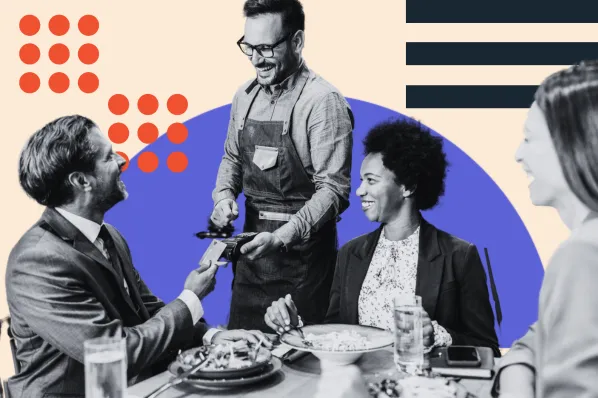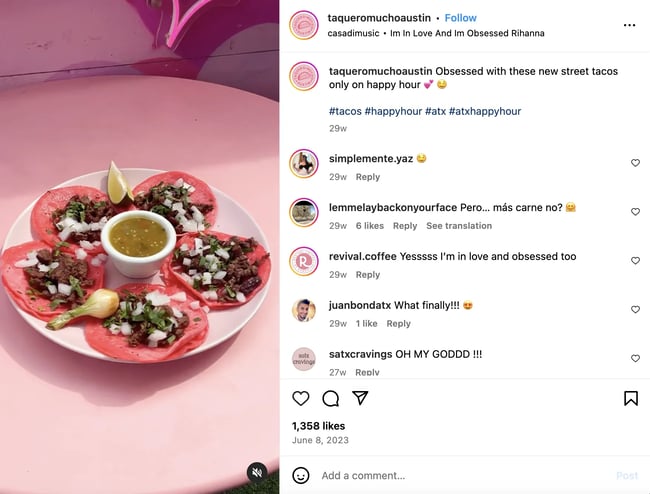
I’m fortunate to live in a city that has a thriving restaurant scene (it’s most known for its barbecue and Tex-Mex, if that gives you any hint). And while I don’t consider myself a food connoisseur by any means, I was a food journalist in a past life, so I continue to stay on top of the latest stories and trends surrounding the restaurant industry.
To do this, I follow a lot of restaurants on social media. I also subscribe to their newsletters, attend their special events, enter their giveaways, and sign up for their rewards programs.
And because my marketing brain never shuts off, I can’t help but be curious about these restaurant marketing strategies. How well do they work? Which channels do these restaurants perform best on? How do established restaurants maintain interest after the grand opening buzz wears down?
To figure out the answers to these questions, I’m digging deep into restaurant marketing ideas, strategies, and real-life campaigns.
Restaurant Marketing Strategies That Work
I wanted to get more insight into the world of restaurant marketing, so I spoke with Rachel Ayotte, the founder and CEO of Bread and Butter, a communications agency that works with hospitality clients.
Why do restaurants of all sizes need a marketing strategy? What does an effective campaign look like these days?
“In New York City alone, there are over 25,000 restaurants, which would take the average person 22 years to try,” shares Ayotte.
She adds, “With a huge inventory of options and a relatively short time to succeed, people must know your restaurant not only exists but is also someplace they want to go.”
This is why having a restaurant marketing strategy is essential.
If you want to stand out online and bring more people into your restaurant, here are examples of successful restaurant marketing strategies and campaigns to take inspiration from.
Customer-First Content
An essential restaurant marketing strategy is to focus on your customers. This applies not only to the way you market your restaurant but also to the menu items and products you create.
One creative example of this is Chipotle’s limited edition Napkin Holder, which is inspired by its customers.
Here’s the backstory: It’s common for Chipotle customers to grab a stack of napkins to store in their cars on their way out of the restaurant.
Instead of reprimanding its customers for stocking up on napkins, Chipotle created an opportunity for increased brand loyalty by creating a branded car napkin holder.
As a bonus, the campaign launched around the holidays, making it a perfect gifting opportunity. Each napkin holder also came with a gift card for a free entree to encourage customers to visit a restaurant to “restock” their napkin supply.
Chipotle’s limited edition Napkin Holder was not only an excellent customer-inspired product, but the campaign was also a perfect example of social listening in action.
By paying attention to their customers’ behaviors and what they’re sharing online about the restaurant, Chipotle was able to create a viral moment out of it.
Chipotle’s goal on social is to “meet [their] fans where they are,” according to Candice Beck, the restaurant’s director of social, influencers, and Web3, and this campaign completely aligns with that strategy.
To employ this strategy, get to know your customers on a deep level. Immerse yourself in the platforms they spend their time on, whether that’s Instagram or TikTok, and make note of their interests, behaviors, and goals.
Nostalgic Marketing
To this day, I can’t hear the words “baby back ribs” and not think of Chili’s. That’s because I, like many millennials, grew up hearing the iconic “I want my baby back ribs” jingle on TV and the radio.
Chili’s has tapped into its Y2K past and created several nostalgic marketing campaigns this year to target its now-adult millennial audience.
The campaigns include a commercial that brought back the restaurant’s famous jingle, now sung by Boyz II Men (another pop culture fixture of the 90s and 2000s).
Using nostalgia in marketing has been a popular strategy in recent years as many businesses’ target audiences are growing up. If you’re an established restaurant, don’t be afraid to rehash the past.
This could mean bringing back an old menu item, selling merchandise with retro branding, or even sharing flashbacks from throughout your restaurant’s history.
Nostalgic marketing works not only because it taps into people’s memories and emotions but also because it serves as a reminder of how long you’ve been around.
Social-Driven Content
In my experience, restaurants that prioritize social media in their marketing strategy tend to generate a lot of online buzz.
An example of a restaurant that creates social-driven content is Austin-based El Arroyo. Even though El Arroyo is a Mexican restaurant, you won’t find any pictures of food on its Instagram.
With almost 700K followers, the restaurant is instead known for its real-life marquee sign that displays cheeky jokes and thoughts, often submitted by fans.
The account shares a picture of its sign with a new message every day on Instagram.
El Arroyo has built a large following around its daily sign, giving its audience something to look forward to seeing — and sharing — every day.
The restaurant also uses its sign to tie in current events or make major announcements. For example, when the hit Netflix show, Queer Eye, was filming in Austin, El Arroyo partnered with the cast to generate buzz.
If you want to use social media to drive traffic to your restaurant, create something shareable. This could be a mural or a sign that people want to take pictures of or a unique menu item that would stand out in the feed.
Signature Brand
When I think of a restaurant with a signature, distinct, and memorable brand, the first place that comes to mind is Taquero Mucho.
The Austin-based restaurant is known for using the color pink in everything — from its decor to its margaritas — even the tortillas are pink.

Pink is splashed across its brand imagery, making it unmissable online and in social media feeds. The color pink often evokes a feeling of playfulness, optimism, and femininity, which are all words I’d use to describe Taquero Mucho.
Creating a strong brand is a great way to make your restaurant memorable, as a signature brand essentially markets your restaurant for you.
Brand Partnerships
“One of our favorite and most effective marketing ideas for restaurants to maximize awareness is a partnership with a like-minded brand to tap into their audience,” shares Ayotte.
Ayotte says this is a low-lift way to draw on what you already have — a great restaurant and a great menu. You can “leverage that through another brand that shares a similar ethos and has access to customers the restaurant might not,” she notes
An example of a successful partnership Ayotte’s team developed and executed was between the dessert brand, Lady M Confections, Netflix, and Pearl Studio in advance of the release of the highly anticipated musical Over the Moon.
To celebrate the release, Lady M created a mooncake lantern. Once the partnership was ready to be announced, Ayotte’s team reached out to media and influencers to share the news, as well as samples of the mooncake lanterns.
“The partnership was a resounding success,” Ayotte recalls. “It [resulted] in a huge bump in sales for Lady M [and generated] over 1.7 million impressions and 19,804 total social engagements.”
10 Restaurant Marketing Ideas for 2024
Based on the strategies above, along with more insight from Rachel Ayotte and my personal encounters with restaurant marketing that works, here are ten restaurant marketing ideas and best practices to try this year and beyond.
1. Build a simple yet effective website.
Whether I’m searching for a restaurant near me on Google or I’ve discovered a new place through Instagram, my next step is always to check out the restaurant’s website. Having a website for your restaurant is a necessity.
“Even if a restaurant has the best service and best food in the world, guests need a way to find out information and connect in some way,” states Ayotte. “In our experience designing websites for restaurants, we emphasize the need for regularly updated, user-friendly formats that make it easy for guests to see the menu, hours, location, and how to make a reservation.”
What we like: The good news is you don’t need to have website development skills to build an effective website. “Restaurants don’t need a hugely complex website to be successful,” says Ayotte. “A website can be relatively simple if designed well.”
2. Manage and update your Google Business Profile.
In addition to their website, another thing I immediately take a look at when searching for restaurants is their Google Business Profile.
Your Google Business Profile is the profile that pops up on the right side of the screen when someone searches for your business. This snapshot of your business creates a first impression to searchers who want to see what type of food to expect and what the atmosphere is like.
It also displays information they’re most likely looking for right away, such as hours, location, and reviews.
It’s important to keep your profile updated so customers have the most accurate and up-to-date information. Restaurants that actively maintain this information get 89% more calls, website visits, and direction requests, and 79% more reviews, according to data from Mobile.io.
Here’s an example of a Google Business Profile for a local pizza restaurant here in Austin called Via 313:
The profile includes the restaurant’s essential information such as location, hours, and phone number. But it also includes things that can help diners make their decision, like the menu, service options, reviews, and plenty of photos.
Pro tip: You can add your own photos to your profile if you don’t want it to solely feature images from customer reviews.
3. Track online reviews.
“People love to broadcast negative experiences and reviews,” Ayotte states. “This can haunt a restaurant for years.”
While you can’t control what people write in their reviews, you can choose how you respond. Take the time to read and respond to both positive and negative reviews.
Here’s another example from Via 313, the pizza shop I mentioned above. The restaurant takes the time to thoughtfully respond to every customer review on Google, even acknowledging their feedback when customers share it.
Best for: Tracking your restaurant’s online reviews isn’t only so you can stay on top of negative reviews. You can also use customer feedback to improve your restaurant service, get inspiration for new dishes, or collect positive reviews as social proof on your website and social media posts.
4. Share UGC (user-generated content).
For me, seeing posts created by other accounts and customers helps convince me to try a restaurant. This is called user-generated content, or UGC.
UGC establishes social proof, which is the concept that customers are influenced by other customers’ experiences, behavior, and recommendations.
For example, the Reel below was created by a food influencer sharing their experience at the New Orleans-based restaurant Willa Jean (which, by the way, I can confirm is a great brunch spot in the city!).
The restaurant shared the video on its own page to amplify the influencer’s positive recommendation.
What we like: Not only does UGC provide social proof for your restaurant, but it also gives you plenty of content to share, so you never run out of things to post.
5. Join a reservation platform.
If you want to get customers in the door, you have to make it easy for them to come. This often means meeting them where they are, which, in the case of upscale dining, is on the reservation platforms.
Reservation platforms like Resy or Tock are great channels for restaurants to increase their discoverability and get in front of new customers.
On the customer side, these platforms are convenient. Booking platforms often curate restaurants for customers, organizing them into categories such as “Top Rated” or “Best Brunches” so people can navigate their options better.
Resy, for instance, even has a category called “Book Tonight” that displays openings for last-minute reservations.
Pro tip: If you offer reservations or group dining, make it easy for your customers to book a table by adding a reservation page or plugin on your website.
6. Engage customers directly with email marketing.
In 2023, I had one of my most memorable dining experiences at Bar Marilou in New Orleans. From the library-inspired interior design to the mouth-watering bites and flavorful drinks, the experience has stuck with me for nearly a year.
So, of course, anytime I see the name “Bar Marilou” pop up in my inbox, I immediately open the email just to be reminded of my magical experience.
This is the power of email marketing. When done right, emails can be used to increase customer loyalty and serve as a reminder of your story, your menu, or your events. Email is a way to reach your customers directly, whereas social media posts can get lost in a sea of content.
Bar Marilou only sends out emails once a month (sometimes less) to share upcoming events or updates. This cadence is enough for me since I don’t even live in the same city and can’t easily drop in whenever I want.
However, if you have enough data on your customers, you could send more personalized emails depending on their locations, demographic, and dining history with you. For instance, if you know your customers’ birthdays, you can send them rewards to redeem on their special days.
Best for: If you want to communicate important information or share upcoming events with your customers, email marketing can be a more direct channel than social media.
7. Create shareable moments.
Shareable content is key to succeeding on social media. When you create content that attracts and resonates with people, they’re more likely to share it and help you increase your restaurant’s online reach.
There are a few ways to create moments or content that people want to share. One way is to make your dishes Instagram-worthy so customers are compelled to take pictures and share them.
Here’s another example from the pink restaurant, Taquero Mucho, I mentioned earlier. The restaurant creates a fun new drink every month and shares it on Instagram. This one aligned with the Barbie movie that premiered last summer.
Another way is to design your restaurant in a way that’s share-worthy by creating an Instagrammable spot inside or outside of your space, like a mural.
8. Start a loyalty or rewards program.
Everyone loves free stuff. A rewards program can be a fun way to encourage customers to become frequent visitors to earn free food and drinks.
McDonald’s offers a great example of how to execute a rewards program. To encourage people to use its app, McDonald’s offers customers free large fries when they make a purchase.
The more orders you make in the app, the more points you get and can use towards future orders.
But you don’t need to have a fancy app or be a large restaurant chain like McDonald’s to start a loyalty program.
My local coffee shop, Sorrento’s Coffee, offers a rewards program that’s set up through its POS system, Square.
Every time you buy a drink, you get points. 140 points get you one free drink. (Which reminds me — looks like I have a free coffee or two waiting for me!).
Best for: Loyalty programs are meant to reward frequent customers. In my experience, the rewards programs I’ve been most likely to participate in are places that I already frequent.
These programs work great with coffee shops or lunch spots in a busy office area — anywhere where you’re likely to see the same customers on a regular basis.
9. Create branded merchandise.
Creating physical products or branded merchandise is a great way to let your customers do your marketing for you.
Like the Chipotle campaign I shared above, branded merchandise is a great marketing idea for restaurants with a loyal customer base. The key to creating branded merchandise is to create a product that not only reflects your brand but is also something your customers would enjoy.
For example, El Arroyo, the restaurant with the famous marquee sign, also offers a full line of merchandise that’s synonymous with its sign. The cheeky nature of the sign lends itself well to other gift-type items like doormats, coasters, and playing cards, like the products below.
What we like: Branded merchandise is a great way to encourage customers to promote your brand for you and increase word-of-mouth.
10. Partner with similar brands.
As Ayotte mentioned earlier when talking about restaurant marketing strategies, brand partnerships are an effective way to amplify your brand by getting it in front of new audiences.
To get the most out of your brand partnership, partner with a brand that has a different yet like-minded audience. It doesn’t even need to be another restaurant or food brand. The goal is to be introduced to a new audience that would benefit from or enjoy your product.
For instance, if you’re a small local restaurant that just opened on your town’s main street, you could partner with other small businesses on the block for an in-person event or a social media giveaway.
Pro tip: Brand partnerships should be mutually beneficial. Consider what the other party will receive in return for partnering with you when you make your pitch.
What I Learned About Restaurant Marketing
The biggest thing I’ve learned from digging into different restaurant campaigns and strategies is that there’s a ton of room to be creative with restaurant marketing.
There’s no right or wrong way. Restaurants can incorporate trends in their social posts or stick to publishing high-quality images of their dishes. They can try to get in front of new audiences by partnering with similar brands, or they can build loyalty with current customers through email marketing.
The essential thing your restaurant needs to succeed is a website with the following key information:
- Menu
- Hours
- Location
- Phone number
- Reservations (if applicable)
The best restaurant marketing strategy is to understand your brand and your customers. From there, you can experiment with different online and in-person channels to execute your vision and bring more people into your restaurant for years to come.
![Download Now: Free Marketing Plan Template [Get Your Copy]](https://no-cache.hubspot.com/cta/default/53/aacfe6c7-71e6-4f49-979f-76099062afa0.png)






